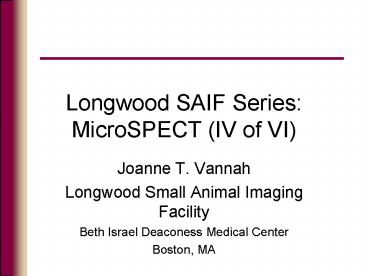Longwood SAIF Series: MicroSPECT IV of VI PowerPoint PPT Presentation
1 / 17
Title: Longwood SAIF Series: MicroSPECT IV of VI
1
Longwood SAIF SeriesMicroSPECT (IV of VI)
- Joanne T. Vannah
- Longwood Small Animal Imaging Facility
- Beth Israel Deaconess Medical Center
- Boston, MA
2
MicroSPECT
- S Single
- P Photon
- E Emission
- C Computed
- T Tomography
Amyloid spleen in a mouse model
Awaiting permission Oak Ridge National
Laboratory http//www.ornl.gov/sci/ismv/research_b
io_spect.shtml
3
How SPECT works
- Gamma ray emissions are the source for
information - Information labeled by radiotracers,
radiopharmaceutical decays, emits a gamma ray - Information is collected through a gamma camera
- Image is reconstructed through data analysis
4
MicroSPECT basics
Parallel Hole Lead/ Tungsten Collimator
Photon Energies 30-300keV
Radio- atom
Gamma Camera
Energy Resolution 14
3-D Similar to CT, rotate collimator 180-360
and perform reconstruction algorithm
5
Radioisotopes
- A radioisotope is an atom with an unstable
nucleus, which is characterized by elevated
energy which may be used to produce a
newly-created radiation particle within the
nucleus, or else to an atomic electron . The
radioisotope, in this process, undergoes
radioactive decay, and emits a gamma ray(s)
and/or subatomic particles. These particles
constitute ionizing radiation.
6
Radioactive decay is an exponential function
- The time for radioactive material to decline to
one half its initial value is termed the half
life - Activity does not fall at a steady rate, but is
an exponential function. - After two half lives the activity falls to ¼ of
the initial value, after three half lives, 1/8 of
the initial value - This pattern will continuously repeat as the
activity falls more slowly towards zero without
ever reaching it
7
Gamma emitting radionuclides for microSPECT
Readily available radioisotopes for use in the
Longwood SAIF
8
Functions of radiolabeled molecules in microSPECT
- Molecules may function as a substrate for
metabolic processes (e.g., 18F) - Molecules may function as a reporter for
physiological processes such as perfusion or
excretion (e.g., 99mTc) - Radionuclide itself molecule of interest,
iodine - Receptor directed molecules are useful for
imaging areas that have increased expression of
the receptor compared to other tissues (e.g.,
somatostatin receptors )
9
Small animal dosing
- Information on dose using the Medical Internal
Radiation Dose (MIRD) incorporates - Specific absorbed fractions (SAF) of energy
- S-values (SAF summed over the energies and
respective yields of the radionuclide decay
spectrum) - Whole body dose in small animals (30 g mouse, 300
g rat) - 6 cGy 90 cGy (mice)
- 1 cGy 27 cGy (rats)
10
Whole body dose very high compared to lethal dose
- Lethal dose 50/30 7 Gy
- Small animals should be carefully monitored when
used in longitudinal radioactive studies
11
Limitations of microSPECT
- Collimator attenuates most incident photons and
reduces the sensitivity of camera system - Large amounts of radiation needed to provide
enough exposure for camera system to detect
scintillation dots to form image - Transmission of photons decay through living
tissue - Results in substantial losses in signal
12
Computed tomography
- Analytical vs iterative algorithms
- Analytical
- Filtered back projection, fast but produces
significant noise - Iterative
- Requires more processing steps but can reduce
reconstruction artifacts - No ideal methods exist
13
Siemens Inveon (MicroSPECT/PET/CT)
Pixelated NaI(Tl) 2.2 mm detector pitch 1
detector head Max spatial resolution lt1
mm Energy resolution 14 Detectable energy
range 30-300 keV
14
Combining structure and functionMicro CT/SPECT
Anatomical detail of microCT in concert with
physiological detail of microSPECT maximizes data
analysis
Amyloid spleen in a mouse model
Awaiting permission Oak Ridge National
Laboratory http //www.ornl.gov/sci/ismv/research
_bio_spect.shtml
15
MicroSPECT applications
- Monitor physiologic functions
- Track metabolic processes
- Complement structural information with
- physiological information
- Determine cerebral specificity stroke, receptor
densities
16
MicroSPECT pros and cons
- Pros
- Relatively long half life tracers, monitor slow
biological processes - Image physiologic functional components
- Good spatial resolution, lt 1mm
- Energy resolution, lt 14
- Cons
- Radiotracers required
- Sensitivity loss through collimators and tissue
17
Summary
- Radiotracers label information of interest
- Signal measured through gamma camera when gamma
rays are emitted - Valuable for capturing the functional details of
physiologic processes

